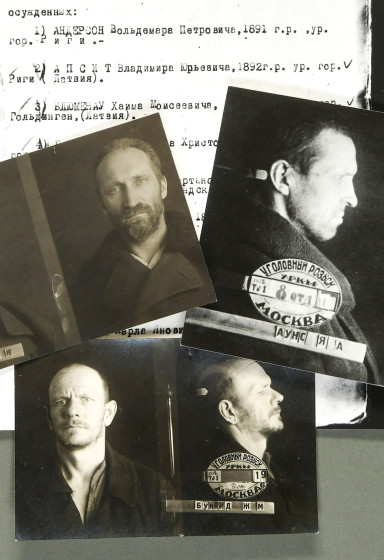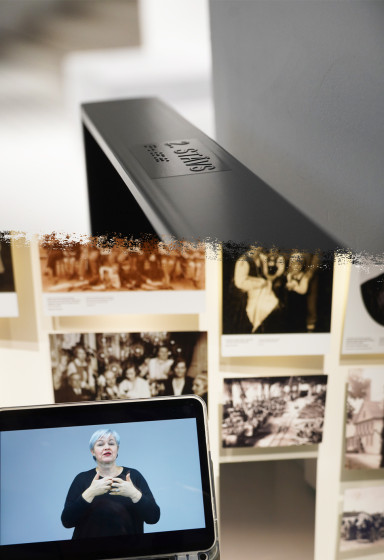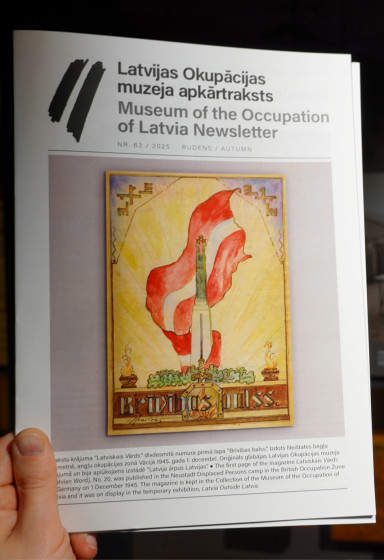Donate to Museum
Each donation helps to ensure the Museum's activities, allowing it to function and provide information for people from all over the world.
The Museum is grateful to each donor and invites everyone to contribute.
The Latvian Legion and 16 March

The exiled Latvian veterans’ organization Daugavas Vanagi, in 1952 in London, decided that 16 March would be the day to hold an annual commemoration to honour fellow veterans that had fallen. This date was chosen because from 16 March to 18 March in 1944, the two divisions of the Latvian Legion – 15th and 19th fought, side-by-side, against the Red Army at Velikaya (Великая) River in Russia. Since 1989/90, former legionnaires and their family members also held public commemorations in Latvia for those fallen and injured on the battlefields of World War II, for the survivors, the exiled, those who passed through Soviet filtration and penal camps and for those who never returned – for all the Latvian soldiers who had to fight wearing foreign uniforms.
The Formation of the Latvian legion
When the German offensive on the Eastern front faltered, and especially after the defeat at Stalingrad (Сталинград) in winter 1942/43, Germany found it necessary to form military units made up of inhabitants of the occupied European countries. The guidelines set out by Hitler, that only Germans may carry arms, were reinterpreted by SS Reichsführer Heinrich Himmler to apply only to participation in the Wehrmacht and not to the SS. Hence Himmler gradually built up his SS army from non-German peoples. On 23 January 1943 Hitler gave verbal permission to Himmler to form a "Latvian SS Volunteer Legion". Hitler’s written order regarding formation of the Legion was issued on 10 February 1943 as follows: "I order the formation of a Latvian SS Volunteer Legion. The size and type of unit to depend on the number of Latvian men available".
Conscription into the “Latvian SS Volunteer Legion”
From March 1943 until September 1944 there were several conscription drives in Latvia. In the beginning, conscription into the Legion was based on a German decree regarding Labour Service duty in occupied Eastern regions. Later the formal legal basis used was the Military Service Law of independent Latvia. Initially the new draftees were offered the limited choice to serve in the Legion, the Wehrmacht or the Labour Service. With the decree on total conscription in July 1944, all men born from 1906 to 1928 were subject to conscription. Conscription was still conducted in Kurzeme in September and October 1944.
Although most obeyed the conscription order, many tried to avoid it or even deserted. Initially the most severe punishment for draft evasion was incarceration for up to six months. On 24 November 1943 a Special War Tribunal was established and given powers to even impose the death sentence. In summer 1944, a decision was taken in Berlin that any person not submitting to conscription within 48 hours could be shot.
The formation of the Legion was in largely the direct result of conscription. There were few true volunteers, not more than 15–20%. The use of the word "volunteers" by the Nazi Occupation powers was a sham, a smoke screen and an attempt to circumvent the 1907 Hague International Convention, which forbade occupying states from conscripting the inhabitants of occupied countries. Nevertheless, in the historical context of the time most of the legionnaires rationalised and equated their role in the Legion as fighting to regain independence for Latvia, despite the fact that they fought as part of the German armed forces. There simply was no other military force that could prevent the return of Soviet occupation. Although most Latvians had been conscripted, they believed that they were fighting against the army of the state that had terminated Latvia's independence, destroyed its army, carried out repressions against civilians, and now threatened to once more occupy Latvia.
Latvian Legionnaires Fighting on the Eastern front
Both 15th and 19th Latvian Waffen-SS Grenadier Division fought in Russia until July 1944, when they retreated under heavy fighting to Latvia. The 19th Latvian Division continued to fight in Eastern Latvia, but at the end of the war were fighting in the western province of Kurzeme. Units of the 15th Latvian Division, which had suffered severe casualties and were sent to Germany for reorganisation, fought in Germany until May 1945. In addition, three police regiments, six border guard regiments, five construction regiments, as well as several separate construction battalions, the Aviation Legion "Latvija" and other Latvian military formations were formed within the German armed forces. Latvians also served in the German Army Auxiliary (Hilfswillige) units, in the German Navy and in other units. In the summer of 1944, young men born in 1927 and 1928, as well as some 1000 girls and women, were assigned to the German Air Force Auxiliary.
The commanders of the 15th and 19th Divisions were Germans, and the Division Headquarters consisted of German officers. The most senior officer in the Legion was Lieutenant General Rūdolfs Bangerskis, Inspector General of the Latvian SS Volunteer Legion. However, his authority was very limited and he could not influence the activities of Legion units under combat conditions as he was specifically denied operational responsibilities. He only had responsibility for the conscription and inspection of legionnaires as to their training and welfare. He was also utilised for propaganda purposes. Altogether some 110 000 to 115 000 Latvian soldiers served in the German armed forces. Some 30 000 to 50 000 lost their lives in the war.
The Latvian Legion and the SS
The armed SS Divisions formed within the German military forces were divided into three categories: 1) German volunteers – SS-Divisionen; 2) volunteers of the Germanic race – SS-Freiwilligen Divisionen; and 3) persons mostly of East European origin – Divisionen der Waffen-SS. The Latvian Legion units were in the third category, meaning that they were not part of but under the command of the SS organisation. Operationally the Legion units were also under the Wehrmacht High Command and their belonging to the SS forces was purely a formality.
In contrast to the oath required of members of the German SS units – pledging allegiance, bravery and obedience until death to the Leader and Chancellor of the German State – Latvian legionnaires had to sign an oath of obedience "in the name of God" to the Commander in Chief of the armed forces of Germany and only in fighting “against Bolshevism”. In addition, initially legionnaires were not officially allowed to wear the SS insignia, although at times it was required. Also, Legionnaires wore additional symbols on their insignia – a rising sun in the 15th Division and a swastika (a widespread traditional Latvian design element long before Hitler adopted it as a symbol of the Nazi movement) in the 19th Division. A special recognition sign on the upper sleeve of the uniform was an armshield in national Latvian colours with or without the designation "Latvija".
After the Second World War, in 1946, the International Nuremberg Military Tribunal declared to be criminal within the meaning of the Charter the group composed of those persons who had been officially accepted as members of the SS and who became or remained members of the organisation with knowledge that it was being used for the commission of acts declared criminal or who were personally implicated as members of the organisation in the commission of such crimes, excluding, however, those who were drafted into membership by the State in such a way as to give them no choice in the matter, and who had committed no such crimes. This exclusion can be applied to most of the Latvian Legionnaires.
From 1946 to 1949 several hundred Latvian soldiers took part in guarding the ongoing proceedings of the Nuremberg trials of Nazi war criminals. On 1 September 1950 the U.S. Displaced Persons Commission stated that "the Baltic Waffen SS Units (Baltic legions) are to be considered as separate and distinct in purpose, ideology, activities and qualifications for membership from the German SS, and therefore the Commission holds them not to be a movement hostile to the Government of the United States." By the early 1950s, many former legionnaires had left Germany for Great Britain, Australia, the USA, Canada and other countries around the world.




